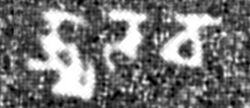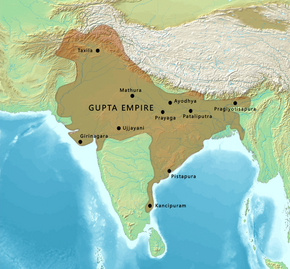History:Malavas
Malavas | |||||||||||||||||
|---|---|---|---|---|---|---|---|---|---|---|---|---|---|---|---|---|---|
| 4th century BCE–7th century CE | |||||||||||||||||
| Template:South Asia in 150 BCE | |||||||||||||||||
| Government | monarchy | ||||||||||||||||
| History | |||||||||||||||||
• Established | 4th century BCE | ||||||||||||||||
• Disestablished | 7th century CE | ||||||||||||||||
| |||||||||||||||||
| Today part of | India | ||||||||||||||||
The Malavas (Brahmi script: 𑀫𑁆𑀫𑀸𑀭𑀯 Mmālava) or Malwas were an ancient India n tribe. Modern scholars identify them with the Mallian people (Malloi) who were settled in the Punjab region at the time of Alexander's invasion in the 4th century BCE. Later, the Malavas migrated southwards to present-day Rajasthan, and ultimately to Madhya Pradesh and Gujarat. Their power gradually declined as a result of defeats against the Western Satraps (2nd century CE), the Gupta emperor Samudragupta (4th century), and the Chalukya emperor Pulakeshin II (7th century).
The Malwa region in central India and the region of Punjab with the same name are both named after them.[1] The Malava era, which later came to be known as Vikram Samvat, was probably first used by them.
Before Common Era
The Malavas are mentioned in several ancient Indian texts, including the Mahabharata and Mahabhashya.[2] According to the Mahabharata, the hundred sons of the Madra king Ashvapati, the father of Savitri were known as the Malavas, after the name of their mother, Malavi.[3] Although Malavas are not specifically mentioned by Panini, his sutra V.3.117 mentions a group of tribes called ayudhajivi samghas (those who live by the profession of arms) and the Kashika includes the Malavas and the Kshudrakas in this group of tribes. The Malavas are also mentioned in the Mahabhashya (IV.1.68) of Patanjali.[4]
The location of the original homeland of the Malavas is not certain, but modern scholars generally connect them with the "Malli" or "Malloi" mentioned in the ancient Greek accounts, which describe Alexander's war against them.[5][6] At the time of Alexander's invasion in the 4th century BCE, the Malloi lived in present-day Punjab region, in the area to the north of the confluence of the Ravi and the Chenab rivers.[5]
Southward migration

Later, the Malavas (or at least a large population of them) migrated to present-day Rajasthan, possibly as a result of the Indo-Greek occupation of Punjab.[5] They were probably headquartered at Malavanagara (present-day Nagar Fort), where several thousands of their coins have been discovered.[7] These coins bear the legend Malavanam jayah ("victory of the Malavas"), and have been dated between 250 BCE and 250 CE.[2] Several inscriptions dated in the Malava era have been found in various parts of Rajasthan, which suggests that the Malava influence extended to a wider part of Rajasthan.[7]
It is also said that the Malavas, originally residing in the Punjab region, migrated to Central India/Rajasthan due to the Huna invasion. [8]
The Malavas ultimately migrated to the Malwa region in central India: this region was named after them some time after the 2nd century CE.[9]
Conflict against the Western Satraps

Around 120 CE, the Malavas are mentioned as besieging the king of the Uttamabhadras to the south, but the Uttamabhadras were finally rescued by the Western Satraps, and the Malvas were crushed.[11] The account appears in an inscription at the Nashik Caves, made by Nahapana's viceroy Ushavadata:
... And by order of the Lord I went to release the chief of the Uttamabhadras, who had been besieged for the rainy season by the Malayas, and those Malayas fled at the mere roar (of my approaching) as it were, and were all made prisoners of the Uttamabhadra warriors.
— Inscription in Cave No.10 of the Nashik Caves.[12]
Conflict with the Guptas
In the 4th century CE, during the reign of the Gupta emperor Samudragupta, the Malavas most probably lived in Rajasthan and western Malwa.[6] The Allahabad Pillar inscription of Samudragupta names the Malavas among the tribes subjugated by him:[13]
(Lines 22–23) (Samudragupta, whose) formidable rule was propitiated with the payment of all tributes, execution of orders and visits (to his court) for obeisance by such frontier rulers as those of Samataṭa, Ḍavāka, Kāmarūpa, Nēpāla, and Kartṛipura, and, by the Mālavas, Ārjunāyanas, Yaudhēyas, Mādrakas, Ābhīras, Prārjunas, Sanakānīkas, Kākas, Kharaparikas and other (tribes)."
— Lines 22–23 of the Allahabad pillar inscription of Samudragupta (r.c.350-375 CE).[14]
The Aulikaras who ruled in the Malwa region may have been a Malava clan, and may have been responsible the name "Malwa" being applied to the region.[9]
Post-Gupta period
Post-Gupta records attest to the Malava presence in multiple regions, including present-day Madhya Pradesh and Gujarat.[16]
Present-day Gujarat
Xuanzang (also 7th century) locates Malava (transcribed as 摩臘婆, "Mo-la-p'o")[17] in present-day Gujarat, describing Kheta (Kheda) and Anandapura (Vadnagar) as parts of the Malava country.[18] Xuanzang suggests that this Malava country was a part of the Maitraka kingdom.[19] Like Banabhatta, he describes Ujjayini ("Wu-she-yen-na") as a distinct territory, but unlike Banabhatta, he locates Malava to the west of Ujjayini. The 7th century Aihole inscription of the Chalukya king Pulakeshin II, who defeated the Malavas, also locates them in present-day Gujarat.[18] The 9th century Rashtrakuta records state that their emperor Govinda III stationed governor Kakka in the Lata country (southern Gujarat) to check the advance of the Gurjara-Pratiharas into Malava.[19]
Present-day Madhya Pradesh
Although the region that ultimately came to be known as Malwa included Ujjain, the post-Gupta records distinguish between the territory of the Malavas and the region around Ujjain. Banabhatta's Kadambari (7th century) describes Vidisha in present-day eastern Malwa as the capital of the Malavas, and Ujjayini (Ujjain) in present-day western Malwa as the capital of the distinct Avanti kingdom.[7] This Malava king was defeated by the Pushyabhuti king Rajyavardhana around 605 CE, as attested by Banabhatta's Harshacharita as well as the Pushyabhuti inscriptions.[19] The distinction between these Malava and Ujjain regions is also found in the writings of the 9th century Muslim historian Al-Baladhuri, who states that Junayd, the Arab governor of Sindh, raided Uzain (Ujjain) and al-Malibah (Malava) around 725 CE.[20]
From 10th century onward, historical records use the term "Malavas" to refer to the Paramaras, who ruled the present-day Malwa region. It is probable that the Paramaras were descended from the ancient Malavas. Though they came to be called "Malavas" after they started ruling the Malwa region named after the ancient Malavas. [20] In the Yadava-prakasha's Vijayanti (c. 11th century), Avanti (the area around Ujjain) and Malava are stated to be identical. Thus, it appears that the present-day definition of Malwa became popular in the later half of the 10th century.[21]
Malava era
The era, which later became known as the Vikrama Samvat is associated with the Malavas. Initially it was mentioned as the Krita era and then as the Malava era. Most probably this era was mentioned as the Vikrama era for the first time in the Dholpur stone inscription of Chahamana ruler Chandamahasena in 898 CE.[3]
Rulers
- Soma, under whom the Malavas re-asserted their independence from the Sakas of Ujjayini after the death of Rudrasena I[22]
- Vishvavarman circa 423 CE.[10]
- Bandhuvarman, his son and feudatory of Kumaragupta.[10]
See also
- Malwa
- Malwa (Punjab)
References
- ↑ Grover, Parminder Singh; Singh, Davinderjit (2011). "Section 1: Introduction – Regions of Punjab". Discover Punjab: Attractions of Punjab. Photographs by Bhupinder Singh. Ludhiana, Punjab, India: Golden Point Pvt Lmt.. https://books.google.com/books?id=Dy-pOAnlQL0C&q=malwa+punjab&pg=PT16. "Regions of Punjab: The much-truncated India's portion of present Punjab is divided into three natural regions: The Maiha, The Doaba, The Malwa. Majha: Majha starts northward from the right bank of river Beas and stretches up to the Wagha village, which marks the boundary between India and Pakistan. Majha in Punjabi means the heartland. The region is divided into three districts: 1. Amritsar, 2. Gurdaspur, 3. Tarn Taran. Doaba: The rivers Sutlei in the south and Beas in the North bound the Doaba of Puniab. The Doaba region is divided into four districts: 1. Jalandhar, 2. Nawanshahr, 3. Kapurthala, 4. Hoshiarpur. Malwa: The area south of the river Sutlej is called Malwa. The name has stuck because a clan called Molois (sometimes written as Malawis in ancient works) once ruled this area, which must have spread up to present State of Gujrat which was known as the Subah of Malwa as late as the Mughul times. Malwa the largest part of the Punjab is divided into the following 12 districts after the names of their headquarters: 1. Bathinda, 2. Barnala, 3. Faridkot, 4. Fatehgarh Sahib, 5. Ferozepur, 6. Ludhiana, 7. Mansa, 8. Moga, 9. Sangrur, 10. Muktsar, 11. Patiala, 12. Rup Nagar, 13. SAS Nagar - Mohali."
- ↑ 2.0 2.1 Tej Ram Sharma 1978, p. 148.
- ↑ 3.0 3.1 Bela Lahiri 1974, pp. 262-278.
- ↑ B. C. Law 1973, pp. 60-65.
- ↑ 5.0 5.1 5.2 D. C. Sircar 1971, p. 205.
- ↑ 6.0 6.1 Tej Ram Sharma 1978, p. 147.
- ↑ 7.0 7.1 7.2 D. C. Sircar 1971, p. 206.
- ↑ Kapur Singh 1959, p. 340.
- ↑ 9.0 9.1 P. K. Bhattacharyya 1977, p. 147.
- ↑ 10.0 10.1 10.2 Corpus Inscriptionum Indicarum Vol 3 p.72
- ↑ Parmanand Gupta 1989, p. 33.
- ↑ Epigraphia Indica Vol.8 p.78-79
- ↑ Ashvini Agrawal 1989, p. 119.
- ↑ Fleet, John Faithfull (1888). Corpus Inscriptionum Indicarum Vol. 3. pp. 6–10. https://archive.org/details/in.ernet.dli.2015.49403/page/n213/mode/2up.
- ↑ Schwartzberg, Joseph E. (1978). A Historical atlas of South Asia. Chicago: University of Chicago Press. p. 145, map XIV.1. ISBN 0226742210. https://dsal.uchicago.edu/reference/schwartzberg/pager.html?object=182.
- ↑ D. C. Sircar 1971, pp. 207-208.
- ↑ Burgess, Jas. (1906). "Mo-la-p'o, 摩 臘 婆". The Journal of the Royal Asiatic Society of Great Britain and Ireland: 220–222. doi:10.1017/S0035869X00034109. ISSN 0035-869X. https://www.jstor.org/stable/25210226.
- ↑ 18.0 18.1 D. C. Sircar 1971, pp. 206-207.
- ↑ 19.0 19.1 19.2 D. C. Sircar 1971, p. 208.
- ↑ 20.0 20.1 D. C. Sircar 1971, p. 209.
- ↑ D. C. Sircar 1971, p. 210.
- ↑ Ashvini Agrawal 1989, p. 58.
Bibliography
- Ashvini Agrawal (1989). Rise and Fall of the Imperial Guptas. Motilal Banarsidass. ISBN 978-81-208-0592-7. https://books.google.com/books?id=hRjC5IaJ2zcC&pg=PA315.
- B. C. Law (1973). Tribes in Ancient India. Bhandarkar Oriental Research Institute. https://books.google.com/books?id=YApuAAAAMAAJ.
- Bela Lahiri (1974). Indigenous states of northern India, circa 200 B.C. to 320 A.D.. University of Calcutta. https://books.google.com/books?id=vdu1AAAAIAAJ.
- D. C. Sircar (1971). Studies in the Geography of Ancient and Medieval India. Motilal Banarsidass. ISBN 978-81-208-0690-0. https://books.google.com/books?id=AqKw1Mn8WcwC&pg=PA205.
- P. K. Bhattacharyya (1977). Historical Geography of Madhya Pradesh from Early Records. Motilal Banarsidass. ISBN 978-81-208-3394-4. https://books.google.com/books?id=njYpsvmr2dsC&pg=PA147.
- Parmanand Gupta (1989). Geography from Ancient Indian Coins & Seals. Concept. ISBN 978-81-7022-248-4. https://books.google.com/books?id=LzHpZ5N5MhcC&pg=PA33.
- Tej Ram Sharma (1978). Personal and Geographical Names in the Gupta Inscriptions. Concept. p. 258. OCLC 249004782. https://archive.org/details/personalgeograph00sharuoft.
- Kapur Singh (1959). Parasharprasna: Or the Baisakhi of Guru Gobind Sing (an Exposotion of Sikhism). Hind. p. 340. https://books.google.com/books?id=SoP5mUhwU6AC&q=huna+parmars.

